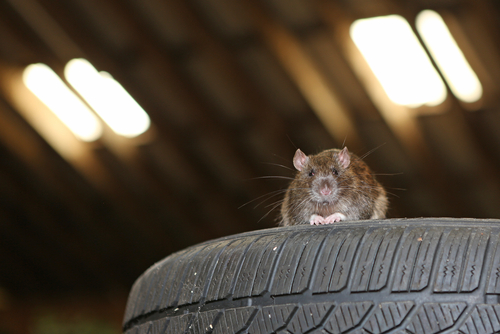Cats v. Rats? In New York, the Rats Win
At a recycling plant in Brooklyn, fat, stealthy rats were more than a match for feral cats, scientists found.
New York rats are big and bad. They sit calmly on the subway tracks, ignoring discomfited commuters on the platform. They stroll through Central Park as if they owned the place. They pretty much rule the East Village.
And they do not have much to fear from cats, a new study suggests.
In the report, published in Frontiers in Ecology and Evolution, the authors first present some background. Cat predation of rats has been studied before: Researchers in New Zealand, for example, analyzed scat from 229 cats and learned that almost all of them ate rats. The felines even seemed to prefer rats to birds.
But New Zealand rats weigh an average of 150 grams, or about five ounces, whereas rats in the most recent experiment in New York were more than twice as large. Bulk, it turns out, is an obstacle for cats who might otherwise dine on city rats.
It was not easy for the scientists to find a place to do their research. The lead author, Michael H. Parsons, a research biologist at Fordham University, said property owners generally want their rats killed, not caught and then released for study.
But the team did eventually find a recycling plant in Brooklyn whose staff members were willing to let the rat detectives do their work.
Dr. Parsons and his colleagues began with another aim: tracking the rodents’ activity at the plant and their reactions to various scents. The scientists captured and anesthetized 37 rats, inserted radio frequency identification tags under the skin of each, and then released them into their colony.
But while the researchers were watching these rats, five feral cats took up residence at the plant, so the team seized the opportunity to study them, too.
Dr. Parsons used motion-sensitive video cameras to record cat behaviors in the presence of rats — walking, running, stalking, chasing, feeding and so on. They made 306 videos over almost three months.
All the cats stalked rats, but over the entire period only two cats even dared to chase and attack a rat. Each made just one kill.
When cats appeared on the scene, rats mostly just hid. For every 1 percent increase in the number of cat appearances on a given day, the researchers found, rats were 100 times less likely to trigger a camera.
Apparently New York rats are not only large and bold, but smart and stealthy.
In any case, the researchers concluded, cats — despite their reputation as rodent killers — are utterly ineffective in controlling urban rat populations.
“A lot of people confuse rats with mice,” Dr. Parsons said. “So they’ve seen their cat bring back a mouse, and assume their cat is a rat killer. It’s not.”
Predation, by cats or any other animal, will not reduce the rat population, Dr. Parsons said. Only cleaning up the garbage — the rats’ food — will do that.
“Rats have a high reproductive rate, and if there’s rubbish around, you’ll have rats no matter what you do,” he said.

